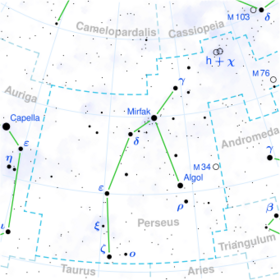Astronomy:32 Persei
| Observation data Equinox J2000.0]] (ICRS) | |
|---|---|
| Constellation | Perseus |
| Right ascension | 03h 21m 26.55723s[1] |
| Declination | 43° 19′ 46.7414″[1] |
| Apparent magnitude (V) | 4.96[2] |
| Characteristics | |
| Spectral type | A3V[3] |
| U−B color index | +0.07[4] |
| B−V color index | +0.04[4] |
| Astrometry | |
| Radial velocity (Rv) | −9.00[5] km/s |
| Proper motion (μ) | RA: −59.947[1] mas/yr Dec.: −0.839[1] mas/yr |
| Parallax (π) | 21.8865 ± 0.2690[1] mas |
| Distance | 149 ± 2 ly (45.7 ± 0.6 pc) |
| Absolute magnitude (MV) | 1.64[2] |
| Details | |
| Mass | 2.05[6] M☉ |
| Radius | 1.8[7] R☉ |
| Luminosity | 21[6] L☉ |
| Surface gravity (log g) | 4.19[8] cgs |
| Temperature | 8,872[6] K |
| Metallicity [Fe/H] | −0.01[9] dex |
| Rotational velocity (v sin i) | 144[6] km/s |
| Age | 125+75 −25[10] Myr |
| Other designations | |
| Database references | |
| SIMBAD | data |
32 Persei is a single[12] star located 149[1] light years away from the Sun in the northern constellation of Perseus.[11] It has the Bayer designation of l Persei, while 32 Persei is the Flamsteed designation. This object is visible to the naked eye as a faint, white-hued star with an apparent visual magnitude of 4.96.[2] It is moving closer to the Earth with a heliocentric radial velocity of −9 km/s,[5] and is a member of the Sirius supercluster: a stream of stars that share a common motion through space.[13]
This is an ordinary A-type main-sequence star with a stellar classification of A3V.[3] It is around 125[10] million years old with a high rate of spin, showing a projected rotational velocity of 144 km/s.[6] The star has double[6] the mass of the Sun and 1.8[7] times the Sun's radius. It is radiating 21[6] times the luminosity of the Sun from its photosphere at an effective temperature of 8,872 K.[6]
References
- ↑ 1.0 1.1 1.2 1.3 1.4 1.5 Brown, A. G. A. (August 2018). "Gaia Data Release 2: Summary of the contents and survey properties". Astronomy & Astrophysics 616: A1. doi:10.1051/0004-6361/201833051. Bibcode: 2018A&A...616A...1G. Gaia DR2 record for this source at VizieR.
- ↑ 2.0 2.1 2.2 Anderson, E.; Francis, Ch. (2012). "XHIP: An extended hipparcos compilation". Astronomy Letters 38 (5): 331. doi:10.1134/S1063773712050015. Bibcode: 2012AstL...38..331A. Vizier catalog entry
- ↑ 3.0 3.1 Cowley, A. et al. (April 1969). "A study of the bright A stars. I. A catalogue of spectral classifications". Astronomical Journal 74: 375–406. doi:10.1086/110819. Bibcode: 1969AJ.....74..375C.
- ↑ 4.0 4.1 Mallama, A. (2014). "Sloan Magnitudes for the Brightest Stars". The Journal of the American Association of Variable Star Observers 42 (2): 443. Bibcode: 2014JAVSO..42..443M.Vizier catalog entry
- ↑ 5.0 5.1 Gontcharov, G. A. (2006). "Pulkovo Compilation of Radial Velocities for 35 495 Hipparcos stars in a common system". Astronomy Letters 32 (11): 759–771. doi:10.1134/S1063773706110065. Bibcode: 2006AstL...32..759G.
- ↑ 6.0 6.1 6.2 6.3 6.4 6.5 6.6 6.7 Zorec, J.; Royer, F. (2012). "Rotational velocities of A-type stars". Astronomy & Astrophysics 537: A120. doi:10.1051/0004-6361/201117691. Bibcode: 2012A&A...537A.120Z. Vizier catalog entry
- ↑ 7.0 7.1 Allende Prieto, C.; Lambert, D. L. (1999). "Fundamental parameters of nearby stars from the comparison with evolutionary calculations: Masses, radii and effective temperatures". Astronomy and Astrophysics 352: 555–562. Bibcode: 1999A&A...352..555A. Vizier catalog entry
- ↑ David, Trevor J.; Hillenbrand, Lynne A. (2015). "The Ages of Early-Type Stars: Strömgren Photometric Methods Calibrated, Validated, Tested, and Applied to Hosts and Prospective Hosts of Directly Imaged Exoplanets". The Astrophysical Journal 804 (2): 146. doi:10.1088/0004-637X/804/2/146. Bibcode: 2015ApJ...804..146D. Vizier catalog entry
- ↑ Gontcharov, G. A. (2012). "Dependence of kinematics on the age of stars in the solar neighborhood". Astronomy Letters 38 (12): 771–782. doi:10.1134/S1063773712120031. Bibcode: 2012AstL...38..771G. Vizier catalog entry
- ↑ 10.0 10.1 Meshkat, Tiffany et al. (December 2017). "A Direct Imaging Survey of Spitzer-detected Debris Disks: Occurrence of Giant Planets in Dusty Systems". The Astronomical Journal 154 (6): 21. doi:10.3847/1538-3881/aa8e9a. 245. Bibcode: 2017AJ....154..245M.
- ↑ 11.0 11.1 "32 Per". SIMBAD. Centre de données astronomiques de Strasbourg. http://simbad.u-strasbg.fr/simbad/sim-basic?Ident=32+Per.
- ↑ Eggleton, P. P.; Tokovinin, A. A. (2008). "A catalogue of multiplicity among bright stellar systems". Monthly Notices of the Royal Astronomical Society 389 (2): 869. doi:10.1111/j.1365-2966.2008.13596.x. Bibcode: 2008MNRAS.389..869E.
- ↑ Palous, J.; Hauck, B. (July 1986), "The Sirius supercluster", Astronomy and Astrophysics 162: 54–61, Bibcode: 1986A&A...162...54P.
 |


